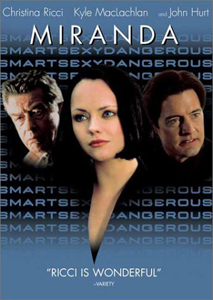During a brief British swing that included the paycheck horror film “The Gathering” (2003), Christina Ricci tried a creative art piece, “Miranda” (2002). The lone writing credit of Rob Young, this is likely the only film in the center of a Venn diagram of “Glengarry Glen Ross,” “La Femme Nikita” and “(500) Days of Summer.”
Ricci is sexual and sensual but a little flat in the title role, maybe because Miranda reads as such a work of fiction. As British narrator and main character Frank (John Simm) bluntly surmises at one point: “Was I in love with a girl who didn’t exist?”
As we eventually find out after a quirky but slow-developing start focused on milquetoast Frank, homeless kid Miranda had been plucked from the streets of New Jersey by con man Christian (John Hurt). They run real-estate scams that are so unlikely that people who have bought Florida swampland wouldn’t even be tricked.

“Miranda” (2002)
Director: Marc Munden
Writer: Rob Young
Stars: Christina Ricci, John Simm, Kyle MacLachlan
The unconvincing nature of the con’s details (or lack thereof) might be the reason director Marc Munden and his team pepper “Miranda” with touches of incongruous whimsy, from the 8-bit-style opening graphics to the lilting score by Murray Gold. IMDb even includes “comedy” among the genres.
An implausible con
The “father”-“daughter” duo sells buildings they don’t actually own – and which are about to be demolished – to businessmen who are fooled by Christian’s basic falsehoods and Miranda’s attractiveness. It’s such a simple scheme that it took me a long time to even figure out what they were doing.
The parallel to later film “(500) Days of Summer” comes from the fact that Frank, a librarian whose innocence in the flirting game is accidentally effective, falls for Miranda, but she doesn’t love him back. “(500) Days” is a lesson for men that women will not automatically return their feelings. But “Miranda” is in movie fantasy-land – that of course could make it appealing in a way, rather than a lesson in how men break their own hearts.
It’s true that Frank has created an idealized, warm and caring version of Miranda in his mind, and that’s not the real Miranda. However, in this case, there is no “real” Miranda, because she has lived her whole life doing the bidding of Christian, feeling she owes him.
She’s a bad person, but not by choice. She’s also not a good person, because she’s never gotten to explore the possibility of being good. In her early 20s, she has not become anything yet. Miranda (if that’s even her name) is a beautiful, blank slate with big eyes (sometimes blue, sometimes brown).

Normally it’s a bad idea for a man to try to “save” a woman – or for any human to “save” another human. People have to save themselves. But Miranda is coming from such a weird and bad place that she actually does need saving. So Frank’s behavior that would normally be so ill-advised is accidentally appropriate for this only-in-fiction situation.
There’s something here, but also something is off
Munden contributes style here and there, like a “Minority Report”-esque overhead “cutaway” shot where we see Miranda and Frank laying on the carpet of his apartment as the bustle of London happens mere feet away, separated by a wall. But none of it particularly improves the viewing experience.
As noted, “Miranda” is a blend of three types of films. But it doesn’t totally believe in any of the concepts, so the way it hangs together feels loose and contrived. Ricci, Simm, Hurt and Kyle MacLachlan (as a distractingly “American Psycho”-esque businessman caught in one of Miranda’s honey traps) are fine, yet I disbelieve many individual scenes.
That “Miranda” jells into a semblance of a complete statement suggests that Young was onto something. Yet, while it’s not a cheap-looking film – cinematographer Ben Davis and the location and set scouts nicely show off London – something else is off. I think it should’ve laser-focused on the Frank-Miranda relationship, with the other elements of her life being communicated, but not at the expense of that core romance.
My post-film thoughts about “Miranda” are richer than my experience of watching it. I don’t want to rate it too highly because it obviously falls short of its ambitions, but I also don’t want to rate it too low because at least this is an attempt at an original, artistic film by the top-billed Ricci.
It’s totally lost amid her better films, but also a fascinating discovery for fans digging through her catalog. I’m not convinced “Miranda” is good, but I am sold on it being interesting. I hope I wasn’t conned.

